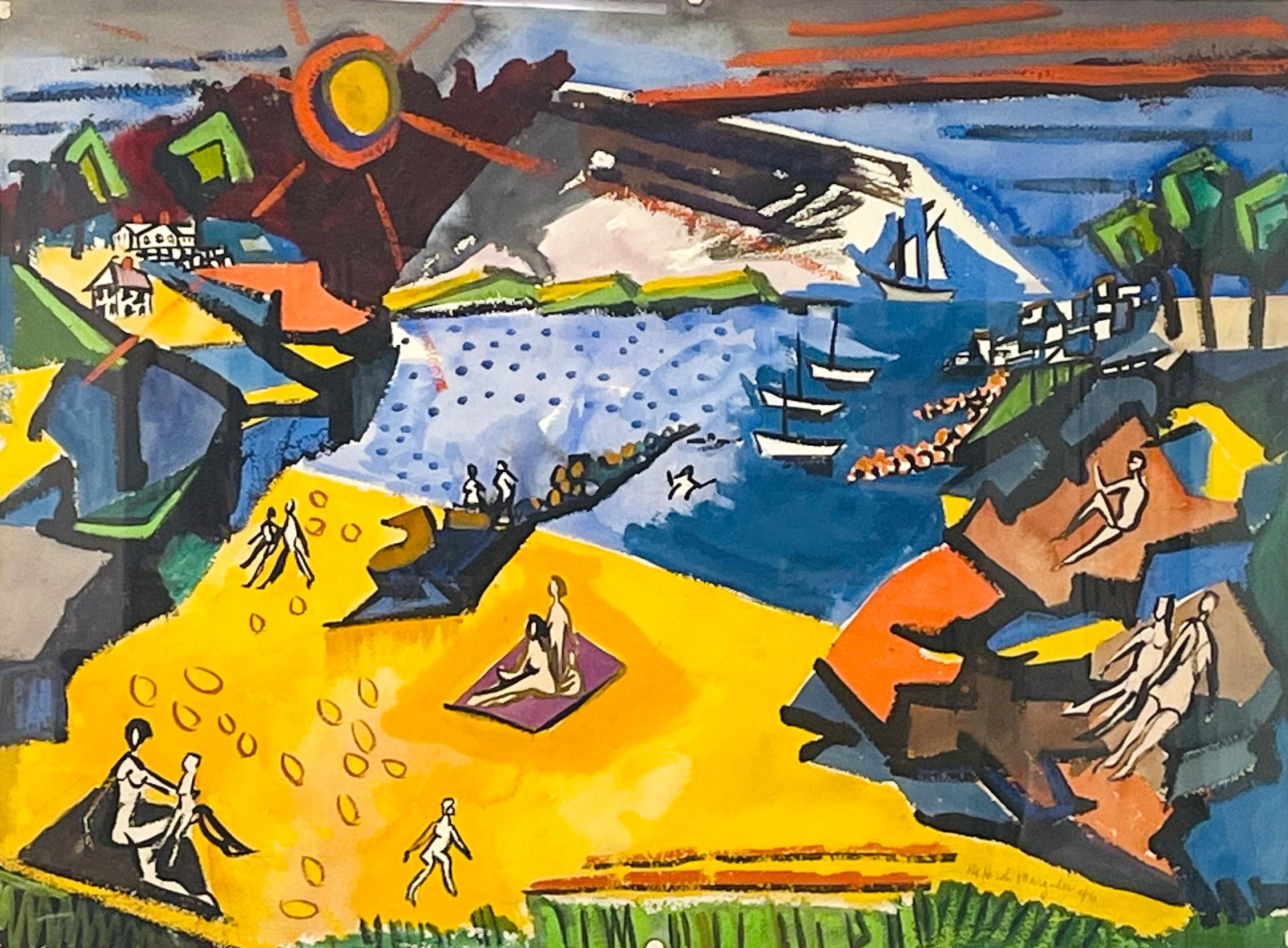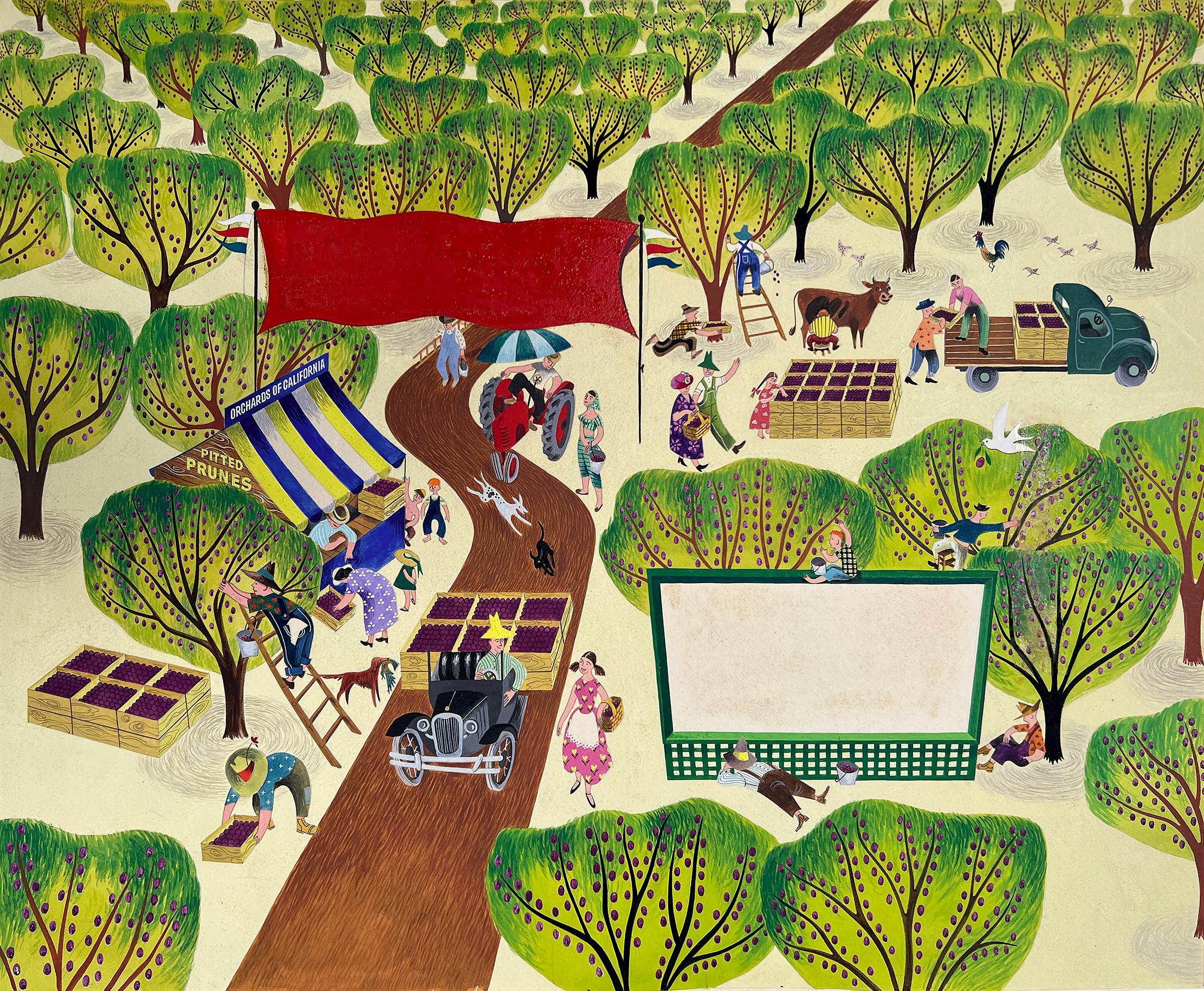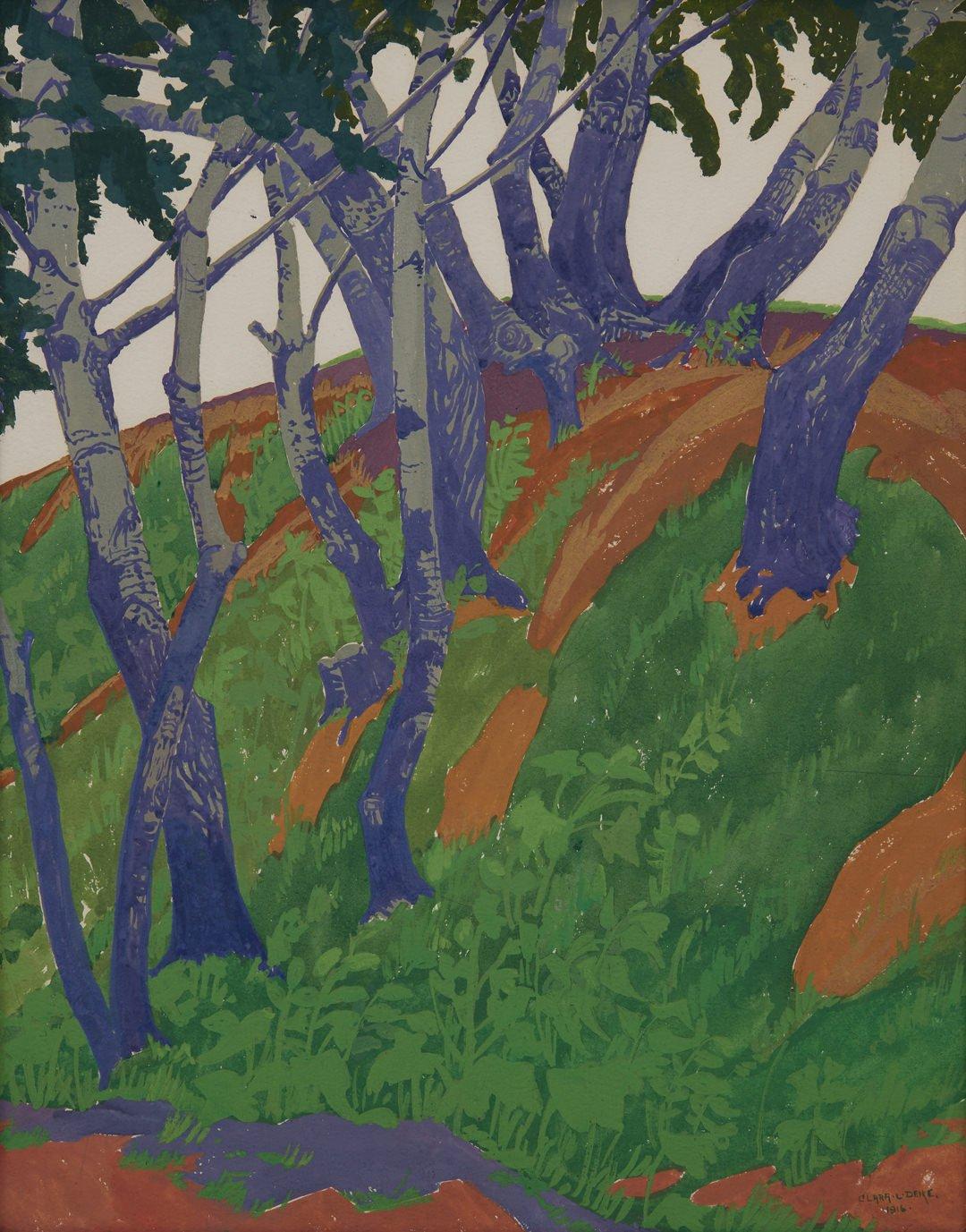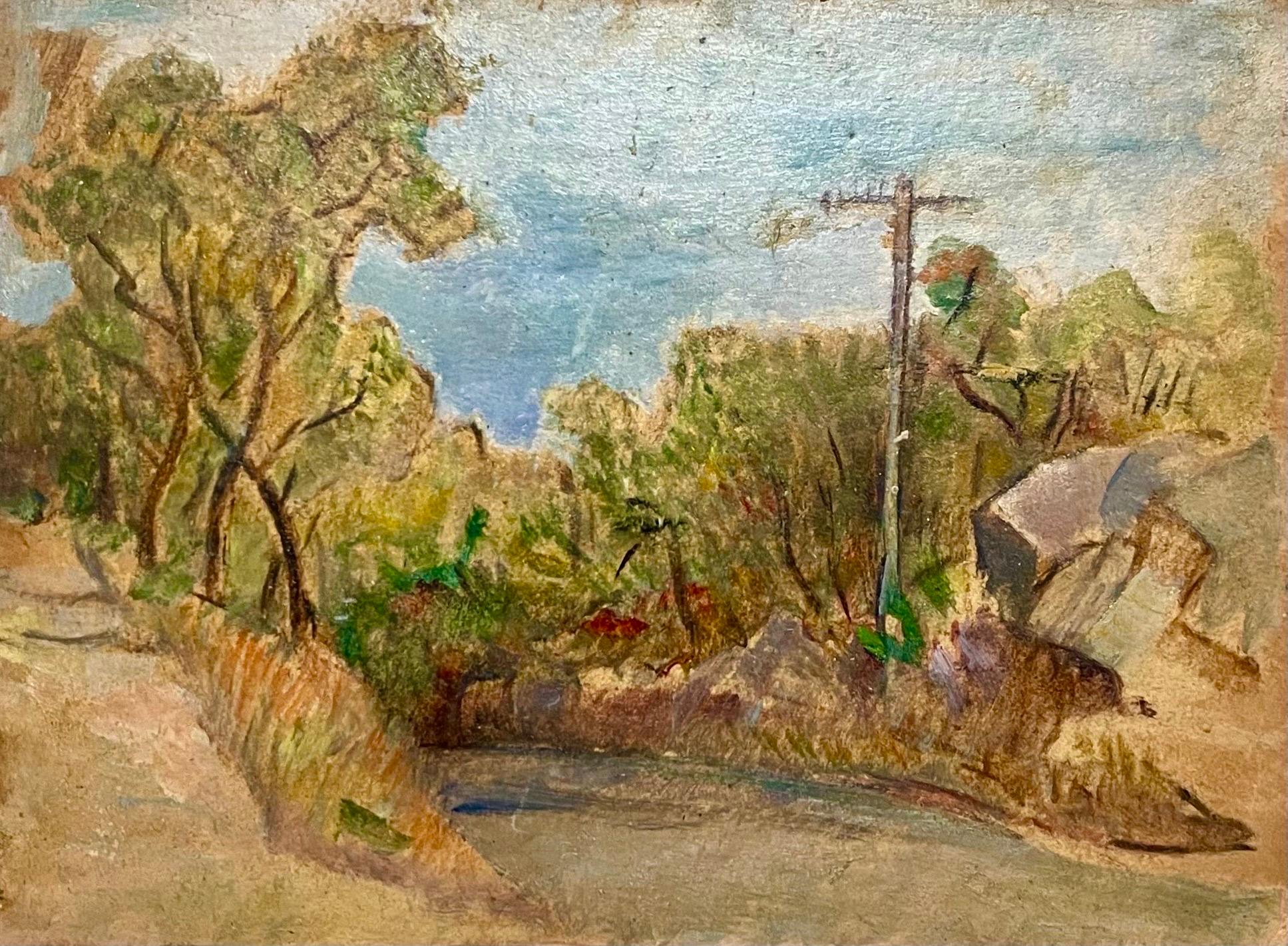Items Similar to Pierre Charbonnier, The Factory near the River, gouache on cardboard
Want more images or videos?
Request additional images or videos from the seller
1 of 8
Pierre CharbonnierPierre Charbonnier, The Factory near the River, gouache on cardboard
About the Item
Pierre Charbonnier (1897-1978)
The Factory near the River
Gouache on cardboard
25,5 x 19,6 inch
Frame : 50 x 70 cm
Born in 1897 in Vienne (Isère), Pierre Charbonnier was predestined for an artistic career from an early age. He received his first training at the School of Fine Arts in Lyon in 1915 before moving to Paris where he joined the Académie Ranson. He presented his first paintings at the Salon des Indépendants, the Salon des Tuileries and the Salon d'Automne in the early 1920s. He also exhibited in galleries in France (Henriette Gomès Gallery, Albert Loeb Gallery) and abroad (Italy, Japan, Brazil, Luxembourg). Active in the film industry, he also distinguished himself as a decorator, notably for the filmmaker Robert Bresson from 1934 to 1970, but also as a director.
The theme of water is very present in the work of Pierre Charbonnier, who grew up on the banks of the Rhône (ill.1). The artist often situates his landscapes and other urban views, without which it would be difficult to identify the places in question (Drôme, Sète, Lyon, Barcelona etc.)(ill.2). Living between Paris and the Drôme region, Pierre Charbonnier paints many uncluttered urban views with a constant concern for framing, reflecting a sensitive eye for photographic and cinematographic shots. These sometimes reveal the frame of a window (ill.3) opening onto a large perspective. His compositions are often highly geometric, featuring urban elements in a static atmosphere. They are punctuated by large lines, sometimes horizontal, sometimes vertical, creating large voids. In the aftermath of the Second World War, his paintings illustrate in a falsely naïve way the invasion of urban space by concrete constructions, over which he casts an angelic gaze.
As the gouache on this site shows, the artist depicts the modern city in the throes of transformation, a city of factories and buildings incorporating metal infrastructures, long chimneys and technical materials, such as the Centre Pompidou inaugurated in 1977 (ill.4). Mostly inanimate, Pierre Charbonnier's landscapes of pure, intense color express the poetry of the modern post-war world. This refinement is also reflected in the artist's keen interest in poetry, which he shares with friends such as Max Jacob, Tristan Tzara, René Char, Jacques Prévert and Blaise Cendrars.
- Creator:Pierre Charbonnier (1897 - 1978, French)
- Dimensions:Height: 25.6 in (65 cm)Width: 19.69 in (50 cm)
- More Editions & Sizes:Original workPrice: $2,003
- Medium:
- Movement & Style:
- Period:
- Condition:Gouache chips and tiny cracks visible on photos.
- Gallery Location:PARIS, FR
- Reference Number:1stDibs: LU2661214359642
About the Seller
5.0
Vetted Seller
These experienced sellers undergo a comprehensive evaluation by our team of in-house experts.
Established in 2018
1stDibs seller since 2023
- ShippingRetrieving quote...Ships From: PARIS, France
- Return PolicyA return for this item may be initiated within 14 days of delivery.
More From This SellerView All
- Petit Rhône, Gouache varnish on cardboardLocated in PARIS, FRPierre Charbonnier (1897-1978) Small Rhone Gouache varnish on cardboard Signed "P. Charbonnier" and titled "Petit Rhône" lower right 15 x 20,5 inch Frame : 50 x 70 cm Born in 1897 i...Category
Mid-20th Century Modern Landscape Paintings
MaterialsGouache
- Aquarium, circa 1935, oil on panelBy Lydia RaddaLocated in PARIS, FRLydia Radda (1891-1967) Aquarium, circa 1935 Oil on panel Signed “Radda” lower right 13 x 16 inch Painter born in Corbeil-Essonnes in 1891, Julie Florent was active in Paris at the ...Category
Early 20th Century Modern Landscape Paintings
MaterialsOil, Paint
- Paris, Saint-Martin canal, c. 1989, oil on canvasLocated in PARIS, FREmilio Trad (né en 1953) Paris, Saint-Martin canal, c. 1989 Oil on canvas Signed lower right 25,5 x 31,5 inch Emilio Trad, an artist of Lebanese origin bo...Category
1980s Landscape Paintings
MaterialsOil, Canvas
- Hubert Aicardi, Landscape, tree trunks, 1964, oil on canvasLocated in PARIS, FRHubert AICARDI (1922-1991) Landscape, tree trunks, 1964 Oil on canvas Signed and dated "64" lower right 46 x 55 cm ubert Aicardi is a painter of the Provençal school born in Marseil...Category
Mid-20th Century Landscape Paintings
MaterialsOil
- Portrait of a woman with a toothache, circa 1900, oil on canvasLocated in PARIS, FRJulien-Auguste HERVÉ (1854-1932) Toothache, circa 1900 Oil on canvas Signed "JULIEN HERVE" and dated lower right 61.5 x 50 cm Born in 1854 in Basse-Indre, Loire-Atlantique, Julien-A...Category
Early 20th Century Portrait Paintings
MaterialsOil
- Bilboquet player, 1879Located in PARIS, FRAfter an initial training at the Toulouse School of Fine Arts, Jules-Arsène Garnier joined the Paris School of Fine Arts in 1867 in Jean-Léon Gérôme's studio. As an academic artist, ...Category
1870s Figurative Paintings
MaterialsCanvas, Oil
You May Also Like
- Untitled Maine Beach SceneLocated in Lawrence, NYElaine de Kooning said of De Hirsh Margules that he was "[w]idely recognized as one of the most gifted and erudite watercolorists in the country", and New York Times critic Howard Devree stated in 1938 that "Margules uses color in a breath-taking manner. A keen observer, he eliminates scrupulously without distortion of his material." Devree later called Margules "one of our most daring experimentalists in the medium." In 1929, Margules attended an exhibition of John Marin’s paintings. While at the exhibition, he "launched into an eloquent explanation of Marin to two nearby women", and was overheard by an impressed Alfred Stieglitz. The famous photographer and art promoter invited Margules to dine with his wife, the artist Georgia O’Keeffe, and his assistant, painter Emil Zoler. Stieglitz thereafter became a friend and mentor to Margules, becoming for him "what Socrates was to his friends." Stieglitz introduced Margules to John Marin, who quickly became the most important painterly influence upon Margules. Elaine de Kooning later noted that Margules was "[i]ndebted to Marin and through Marin to Cezanne for his initial conceptual approach." His work can be found in the collections of the Whitney, MOMA, Boston Museum of Fine Art, the Brooklyn Museum and the Provincetown Art...Category
1940s Modern Figurative Paintings
MaterialsGouache
- Happy California Prune Farmers - Female Illustrator - Mid CenturyLocated in Miami, FLCommercial illustration depicting happy California framers for California Prunes. The work is rendered in a charming and highly stylized manner. Unfr...Category
1950s American Modern Figurative Paintings
MaterialsGouache
- Hillside and Stream, early 20th century modernist Cleveland School paintingLocated in Beachwood, OHClara Deike (American, 1881-1964) Hillside and Stream, 1916 Gouache on paper Signed and dated lower right 22 x 18 inches 25.5 x 21.5 inches, framed A graduate of the Cleveland Schoo...Category
1910s American Modern Figurative Paintings
MaterialsGouache
- Simka Simkhovitch WPA Artist Oil Painting Gouache American Modernist PowerlineBy Simka SimkhovitchLocated in Surfside, FLSimka Simkhovitch (Russian/American 1893 - 1949) This came with a small grouping from the artist's family, some were hand signed some were not. These were studies for larger paintings. Simka Simkhovitch (Симха Файбусович Симхович) (aka Simka Faibusovich Simkhovich) (Novozybkov, Russia May 21, 1885 O.S./June 2, 1885 N.S.—Greenwich, Connecticut February 25, 1949) was a Ukrainian-Russian Jewish artist and immigrant to the United States. He painted theater scenery in his early career and then had several showings in galleries in New York City. Winning Works Progress Administration (WPA) commissions in the 1930s, he completed murals for the post offices in Jackson, Mississippi and Beaufort, North Carolina. His works are in the permanent collections of the Dallas Museum of Art, the National Museum of American Art and the Whitney Museum of American Art. Born outside Kyiv (Petrograd Ukraine) into a Jewish family who owned a small department store. During a severe case of measles when he was seven, Simcha Simchovitch sketched the views outside his window and decided to become an artist, over his father's objections. Beginning in 1905, he studied at the Grekov Odessa Art School and upon completion of his studies in 1911 received a recommendation to be admitted to the Imperial Academy of Arts. Though he enrolled to begin classes in architecture, painting, and sculpture at the Imperial Academy, he was dropped from the school roster in December because of the quota on the number of Jewish students and drafted into the army. Simchovitch served as a private in the 175th Infantry Regiment Baturyn [ru] until his demobilization in 1912. Re-enrolling in the Imperial Academy, he audited classes. Simka Simkhovitch exhibited paintings and sculptures in 1918 as part of an exhibition of Jewish artists and in 1919 placed 1st in the competition "The Great Russian Revolution" with a painting called "Russian Revolution" which was hung in the State Museum of Revolution. In 1922, Simkha Simkhovitch exhibited at the International Book Fair in Florence (Italian: Fiera Internazionale del Libro di Firenze). In 1924, Simkhovitch came to the United States to make illustrations for Soviet textbooks and decided to immigrate instead. Initially he supported himself by doing commercial art and a few portrait commissions. In 1927, he was hired to paint a screen for a scene in the play "The Command to Love" by Fritz Gottwald and Rudolph Lothar which was playing at the Longacre Theatre on Broadway. Art dealers began clamoring for the screen and Simkhovitch began a career as a screen painter for the theater. Catching the attention of the screenwriter, Ernest Pascal, he worked as an illustrator for Pascal, who then introduced him to gallery owner, Marie Sterner. Simkhovitch's works appeared at the Marie Sterner Gallery beginning with a 1927 exhibit and were repeated the following year. Simkhovitch had an exhibit in 1929 at Sterner's on circus paintings. In 1931, he held a showing of works at the Helen Hackett Gallery, in New York City and later that same year he was one of the featured artists of a special exhibit in San Francisco at the California Palace of the Legion of Honor in Lincoln Park. The exhibit was coordinated by Marie Sterner and included four watercolors, including one titled "Nudes". He is of the generation of Russian Soviet artists such as Isaac Pailes, Serge Charchoune, Marc Chagall, Chana Orloff, Isaac Ilyich Levitan, and Ossip Zadkine. In 1936, Simkhovitch was selected to complete the mural for the WPA Post office project in Jackson, Mississippi. The mural was hung in the post office and courthouse in 1938 depicted a plantation theme. Painted on the wall behind the judge’s bench, “Pursuits of Life in Mississippi”, a depiction of black workers engaged in manual labor amid scenes of white professionals and socialites, was eventually covered over in later years during renovations due to its stereotypical African American imagery. Simka painted what he thought was typical of Jackson. His impression of pre-civil rights Mississippi was evidently Greek Revival column houses, weeping willow trees, working class families, and the oppression of African Americans. He painted African American men picking cotton, while a white man took account of the harvest and a white judge advised a white family, calling it Pursuits of Life in Mississippi. Though clearly endorsed by the government and initially generally well-received, the mural soon raised concerns with locals as the climate toward racial segregation began to change. The main concern was whether depictions that show African Americans in subjugated societal roles should be featured in a courtroom. The following year, his painting "Holiday" won praise at an exhibition in Lincoln, Nebraska. In 1940, Simkhovitch's second WPA post office project was completed when four murals, "The Cape Lookout Lighthouse and the Orville W. Mail Boat", "The Wreck of the Crissie Wright", "Sand Ponies" and "Canada Geese" were installed in Beaufort, North Carolina. The works were commissioned in 1938 and did not generate the controversy that the Jackson mural had. The main mural is "The Wreck of the Crissie Wright" and depicts a shipwreck which had occurred in Beaufort in 1866. "The Cape Lookout Lighthouse and the Orville W. Mail Boat" depicted the lighthouse built in 1859 and the mail boat that was running mail during the time which Simkhovitch was there. The boat ran mail for the area until 1957. "Sand Ponies" shows the wild horses common to the North Carolina barrier islands and "Canada Geese" showed the importance of hunting and fishing in the area. All four murals were restored in the 1990s by Elisabeth Speight, daughter of two other WPA muralists, Francis Speight...Category
1930s American Modern Landscape Paintings
MaterialsGouache, Oil, Board
- Ladies in conversationLocated in Genève, GEWork on paper Golden wooden frame with glass pane 38.7 x 31 x 1.5 cmCategory
Mid-20th Century Modern Figurative Paintings
MaterialsCrayon, Watercolor, Gouache
- 1950's French Impressionist Painting Ladies Gossiping On The Town BridgeLocated in Cirencester, GloucestershireLadies Gossiping by Y. Blanchon, French 1950's Impressionist artist signed gouache on artist paper stuck on paper, unframed size: 12.5 x 19.5 inches provenance: from a large private ...Category
Mid-20th Century Modern Landscape Paintings
MaterialsGouache
Recently Viewed
View AllMore Ways To Browse
The Factory
Art Concrete Construction
Robert Bresson
Urban Vintage Paris
Jacques Pierre
Modern Naive
Horizontal Mid Century Art
Mid Century Urban Landscapes
Japanese Window
Midcentury Urban Landscape
Factory Windows
3d Robert
Vintage Luxembourg
Bank Window
Static Vintage
Used Rene Pierre
Vintage Cinematography
Window View Of Paris




